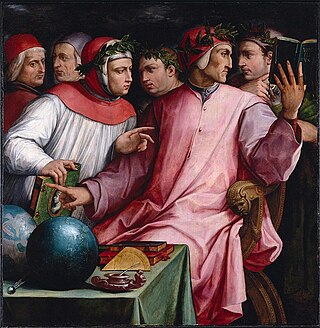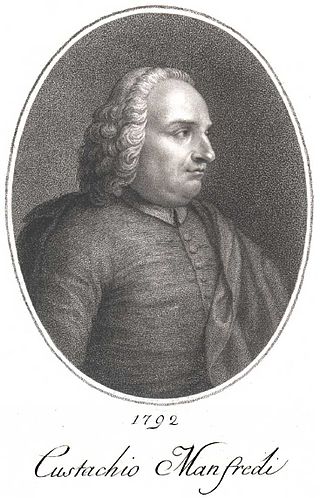Related Research Articles

Girolamo Tiraboschi S.J. was an Italian literary critic, the first historian of Italian literature.

Cesare Cantù was an Italian historian.

Italian literature is written in the Italian language, particularly within Italy. It may also refer to literature written by Italians or in other languages spoken in Italy, often languages that are closely related to modern Italian, including regional varieties and vernacular dialects. Italian literature begins in the 12th century, when in different regions of the peninsula the Italian vernacular started to be used in a literary manner. The Ritmo laurenziano is the first extant document of Italian literature.

Francesco de Sanctis was a leading Italian literary critic and scholar of Italian language and literature during the 19th century.

The Sicilian School was a small community of Sicilian and mainland Italian poets gathered around Frederick II, most of them belonging to his imperial court. Headed by Giacomo da Lentini, they produced more than 300 poems of courtly love between 1230 and 1266, the experiment being continued after Frederick's death by his son, Manfred.

Giacomo da Lentini, also known as Jacopo da Lentini or with the appellative Il Notaro, was an Italian poet of the 13th century. He was a senior poet of the Sicilian School and was a notary at the court of the Holy Roman Emperor Frederick II. Giacomo is credited with the invention of the sonnet. His poetry was originally written in literary Sicilian, though it only survives in Tuscan.

Guido delle Colonne was a 13th-century Italian judge and writer, who lived in Messina. He is the author of a prose narrative of the Trojan War entitled Historia destructionis Troiae, that was based on De excidio Trojae historia written by Dares Phrygius and Ephemeridos belli Trojani written by Dictys Cretensis.

Raffaele La Capria was an Italian novelist and screenwriter.
Giorgio Bàrberi Squarotti was an Italian academic, literary critic and poet. He taught at the University of Turin from 1967 until his death in 2017. He was considered to be one of the most important literary critics of his time.

Girolamo Graziani was an Italian poet and diplomat.
Dante da Maiano was a late thirteenth-century poet who composed mainly sonnets in Italian and Occitan. He was an older contemporary of Dante Alighieri and active in Florence.
Chiaro Davanzati was an Italian poet from Florence, one of the Siculo-Tuscan poets, who introduced the style of Sicilian School to the Tuscan School. He was one of the most prolific Italian authors before Dante: at least 122 sonnets and sixty-one canzoni by Chiaro are known, many of them in tenzone with other poets. Only Guittone d'Arezzo produced more lyrics in the thirteenth century.
Jacopo da Leona, also spelt Iacopo was an Italian medieval jurist and poet who died in 1277.

Eustachio Manfredi was an Italian mathematician, astronomer and poet.
Bianco di Santi alias Bianco da Siena or Bianco da Lanciolina was an Italian mystic poet and an imitator of Jacopone da Todi. He wrote several religiously-inspired poems (lauda) that were popular in the Middle Ages. First a wool carder, he eventually became a member of the poor Jesuates, founded by Giovanni Colombini.

Angela Veronese was an Italian poet.

Giorgio Ficara is an Italian essayist and literary critic. He is Full Professor of Italian Literature at the University of Turin.
Giustina Levi-Perotti of Sassoferrato was the 14th-century Jewish author of two Petrarchan sonnets.

Antonio Scurati is an Italian writer and academic. In 2019, he was awarded the prestigious Strega Prize for his novel M: Son of the Century (2018).
Federico Della Valle,, was an Italian baroque dramatist and poet, recognized only in the 20th century as one of the greatest Italian tragedian of the seventeenth century.
References
- Notes
- ↑ Bondanella 255, 551.
- ↑ Kleinhenz 62-64.
- ↑ Bondanella 255.
- ↑ La letteratura italiana vol. 1, pag. 109, Edizione speciale per il Corriere della Sera, R.C.S. Quotidiani S.p.A., Milano 2005; Titolo dell'opera originale: Natalino Sapegno ed Emilio Cecchi (diretta da) Storia della letteratura italiana, Garzanti Grandi opere, Milano 2001 e De Agostini Editore, Novara 2005, ISSN 1824-9280
- Bibliography
- R. Antonelli, ed. (1979). "Sonetti". Giacomo da Lentini. Poesie. Rome.
- Peter Bondanella, Julia Conaway Bondanella, ed. (1996). Cassell dictionary of Italian literature. Continuum. ISBN 978-0-304-70464-4.
- Kleinhenz, Christopher (1986). The early Italian sonnet: the first century (1220-1321). Milella. ISBN 978-88-7048-122-8.